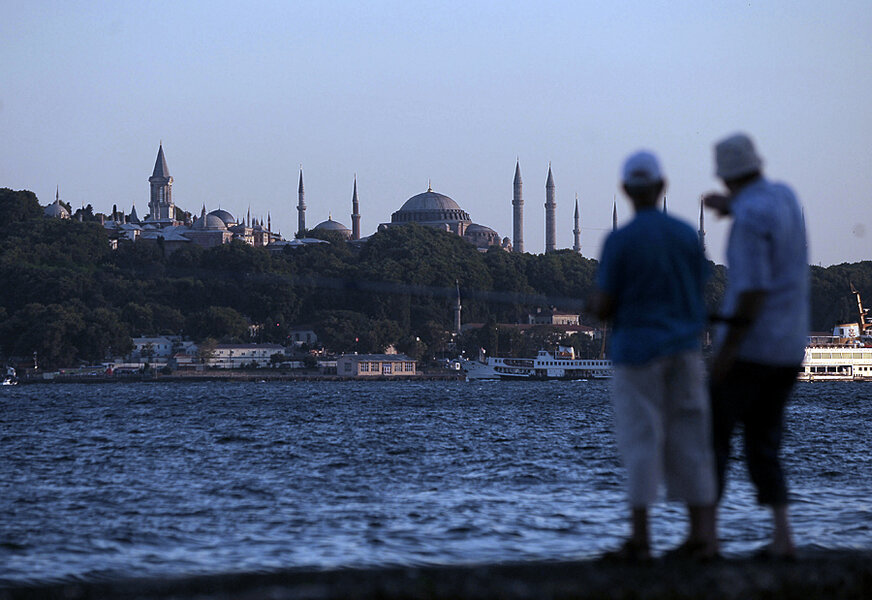Turkey drops a screen over Christianity
Loading...
| Trabzon, Turkey
Many of Turkey’s historic monuments have followed the same path through the centuries: Byzantine church to Ottoman mosque to secular museum. This July, the 13th-century Hagia Sophia church in the eastern city of Trabzon added a new phase: return to mosque.
While the conversion of this Hagia Sophia – not the more famous structure by the same name in Istanbul – to a house of Muslim worship reflects the increasingly religious approach of Turkey's government, the impact on the tourism industry has been buffered by an uptick in foreign visitors from the Middle East, who are largely disinterested in the traditional tourist landmarks.
On a recent Saturday afternoon, Hüseyin Buyuk, a local working for the Historic Hagia Sophia Association, ushered visitors through the divided entrance. Local Muslim worshipers went to the right, removing their shoes before stepping onto the red carpet inside, where large white screens shield Christian icons from their eyes, while non-Muslim tourists went to the left, following an uncarpeted passageway behind the screens to gaze upon bright frescoes depicting Christ.
From 1964 until December 2012, Trabzon’s Hagia Sophia functioned as a museum. But after a court ruling that, in the legacy of Ottoman Sultan Mehmet II, the building was rightfully a mosque, the Turkish Ministry of Culture was evicted. On July 5, the late-Byzantine church reopened as a mosque in time for the first Friday prayer of Ramadan.
“It has always been a house of worship,” Mr. Buyuk says, supporting the court ruling. “We already have a cultural museum.”
The Hagia Sophia was the second such museum to be converted recently – Iznik’s Hagia Sophia was reopened as a mosque in July 2012 – and it may not be the last. The conservative opposition Nationalist Movement Party (MHP) introduced a bill Nov. 8 to resume Muslim prayer in Istanbul’s famed 4th-century basilica, Hagia Sophia, first converted to a museum in 1935.
Dr. Şükrü Yarcan, a tourism specialist at Nisantasi University, says the restoration of Muslim prayer in historical sites like Trabzon’s Hagia Sophia is unlikely to stop non-Muslim tourists from visiting them, but it contributes to foreign impressions that the country is growing more religious, particularly in more distant regions like North America and East Asia.
“They might think that Turkey is going to be an Islamic country and they might refrain from coming,” said Yarcan. “They might have an image of Turkey as a negative one.”
Although visitors from some parts of the world may be dissuaded, the country has become increasingly popular among vacationers from the Middle East. According to the Istanbul Culture and Tourism Directorate, 1.37 million Arab tourists traveled to Istanbul in 2012, 14.6 percent of the total number of visitors that year, and nearly twice as many as in 2009.
The wave of Middle East vacationers has been welcomed by Turkey’s tourism establishment; a 2011 study by Visa found Arabs spend more than four times more than other tourists.
The easing of Turkish visa restrictions to some Middle Eastern countries in 2010 helped attract travelers. Meanwhile, Turkish Airlines serves 38 cities in the Middle East and North Africa, facilitating direct travel to Istanbul. Domestic unrest in other popular tourism destinations in the region likely also drove up numbers. Many Arab tourists came in search of a cooler place to pass the holiday month of Ramadan.
One thing is certain: they don’t fit the profile of the traditional tourist in Istanbul.
“In the true sense of the word, they are not cultural tourists as we understand,” says Yarcan. In Istanbul they tend to neglect the old city’s museums in favor of upscale restaurants and modern shopping areas. Straddling two continents, Istanbul offers many of the commercial trappings of European cities like Paris and London, but is more socially comfortable for Muslims and Arabs.
On a brisk November afternoon, newlyweds Marwa and Mahmood al Jmal of the United Arab Emirates sipped coffee and smoked a water pipe at a café around the corner from their hotel, the high-end Divan Hotel in central Istanbul. Marwa chose the city for their 10-day honeymoon after two previous trips that left her enchanted.
“It’s everything—the culture, society,” she said of her attraction to Istanbul. “And the weather. We don’t have much cold.”
“We live in the desert,” Mahmood piped in.
Murat Eyüpoğlu, manager of Vazelon Tours in Trabzon, which organizes travel for some 3,000 Arab clients annually in Istanbul and the popular rural Black Sea region, believes the recent upswing in Middle Eastern visitors reflects Turkey’s political openness and shared religion with the region.
“In Europe there’s beautiful nature, like in Switzerland, but they think they won’t feel comfortable there,” said Eyüpoğlu. “In their minds, because this is a Muslim country, they will feel comfortable here.”
As in Istanbul, Middle Eastern tourists to Trabzon are interested in a different set of attractions. European and Orthodox tourists come for the sites, like Hagia Sophia and the Sumela monastery. But Byzantine relics are not the draw for Arab tourists.
“They like the blue and the green,” said Medet Uslu, who works at the Park Hotel in Trabzon, referring to the city’s situation between the Black Sea and the mountains. “It’s like heaven. Paradise.”







